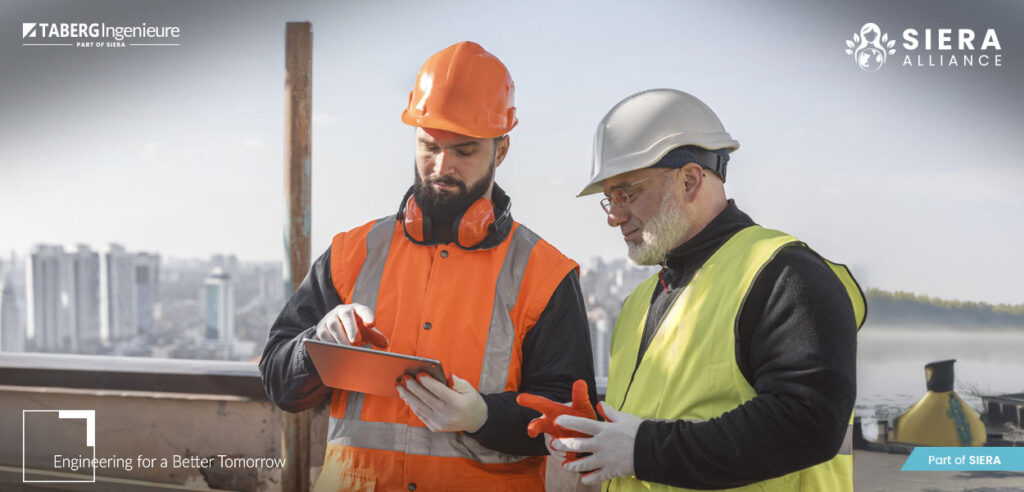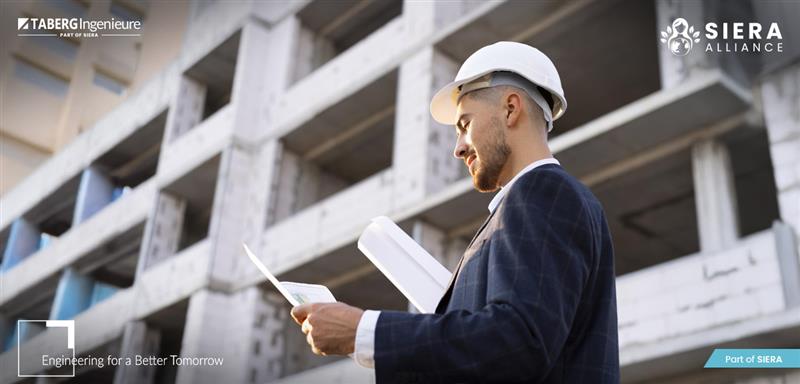Before the first shovel breaks ground, a construction project must undergo extensive planning and risk assessment. One critical component of this preparation phase is the pre-construction-survey: a thorough, evidence-based inspection designed to document existing conditions, identify potential risks and ensure compliance with environmental and structural standards.
For companies like TABERG, which provide engineering and geoscientific consulting services, a pre-construction survey is more than just a legal requirement — it’s a strategic tool for mitigating potential liability and upholding structural quality standards.
In this article, we explore what a construction site inspection is, its core objectives, components and legal significance.
What Is a Construction Site Inspection?
A construction site inspection refers to the systematic evaluation of a construction site to verify safety, compliance, structural integrity and environmental standards. A pre-construction survey — often considered the first and most crucial inspection-specifically focuses on assessing the condition of nearby structures, environmental sensitivities and geotechnical features before work begins.
This process is essential for:
. Documenting baseline conditions
. Forecasting environmental or structural impacts
. Protecting stakeholders from future claims
. Informing regulatory approvals and technical planning
Inspections can be visual, instrument-based, or digitally monitored using construction site inspection software for documentation and data analysis.
Objectives of a Construction Site Inspection
Every construction site inspection serves multiple objectives, each vital for smooth and compliant project execution. These include:
Risk Identification: Detect structural vulnerabilities or environmental risks before they escalate.
Documentation: Establish baseline data through photos, reports and sensor measurements.
Quality Control: Ensure that planned works meet design, safety and regulatory expectations.
Compliance Monitoring: Fulfill legal obligations under environmental building and zoning laws.
Stakeholder Protection: Provide evidence in case of third-party damage claims.
In short, construction site inspections serve as a preventive quality assurance mechanism and legal safeguard for developers, engineers, municipalities and affected communities.

Types of Construction Site Inspections
Different inspection types are conducted throughout the project timeline. The four most common include:
- Preliminary building surveys: Assess property condition, risk zones and local infrastructure before work begins.
- Regular construction progress checks: Conducted regularly to monitor construction progress, worker safety and structural compliance.
- Special inspections: Focused assessments (e.g., vibration or noise monitoring) based on site-specific risks.
- Acceptance and final inspections: Ensure completed structures meet legal and design requirements prior to handover.
Each type of inspection serves a distinct purpose often guided by a tailored construction site inspection checklist and backed by digital tools for streamlined reporting.
What’s Included in a Construction Site Inspection?
A well-executed inspection involves a combination of observational review, instrument-based measurement and formal documentation. Core components may include:
. Photographic and Written Documentation: Visual records and detailed condition of logs of existing structures.
. Geotechnical Measurements: Inclination, point positioning and elevation data.
. Noise, Dust & Vibration Monitoring: To assess potential disturbances to nearby properties.
. Air and Water Quality Testing: For environmental protection compliance.
. Long-Term Instrumentation: Use of 3D fissurometers, electronic sensors or hose scales for real-time monitoring.
Inspection results are often compiled into a property condition survey, serving as a foundational reference point throughout the project lifecycle.
Legal and Regulatory Importance
Construction projects intersect with numerous legal frameworks-including building codes, environmental laws and zoning requirements. Site inspections are key to demonstrating compliance and ensuring legal defensibility. In Germany, for example, permits and approvals must align with regulations such as:
BBegG (Federal Mining Act)
BImSchG (Federal Emission Control Act)
WHG (Water Resources Act)
BNatSchG (Nature Conservation Act)
AbfG/AbfR (Waste Management Regulations)
Authorities require accurate and ongoing documentation to verify compliance with permit requirements. Failure to conduct or document inspections can lead to delays, fines or liability claims - making the role of a certified inspector essential.
How TABERG Supports Construction Site Inspections
With proven Expertise TABERG offers an integrated service portfolio for comprehensive construction site inspections - customised for construction projects of all sizes. This is how we improve the inspection process:
Evidence Preservation & Impact Prognosis: TABERG develops site-specific concepts to preserve evidence and assess expected environmental or structural impacts.
Baseline Property Condition Survey: Pre-existing building and infrastructure conditions are recorded using high-resolution photographs and written protocols.
Geodetic Monitoring: Installation of custom monitoring networks for precision measurements-covering height, angle and positional shifts.
Vibration, Dust & Noise Monitoring: Critical for assessing risks to adjacent properties or habitats.
Advanced Instrumentation: Deployment of long-term monitoring systems like 3D fissurometers and electronic inclination sensors.
Environmental Compliance & Approvals: TABERG navigates the full regulatory landscape-advising on required approvals (e.g., BImSchG), coordinating with authorities and managing public participation process.
Adaptive Project Support: Post-approval, TABERG provides implementation advice, adaptation planning and regulatory monitoring.
Mine Surveying & Mass Calculation: Includes stakeouts, as-built surveys and volumetric assessments.
Nature Conservation & Recultivation: Full-service landscape planning, compensation measure identification and ecological monitoring.
Environmental Due Diligence & Remediation: Evaluation of hazardous building materials, renovation concepts and disposal monitoring.
This holistic approach ensures legal robustness, environmental stewardship and technical excellence.

Benefits of Professional Site Inspections
Partnering with expert consultants like TABERG yields significant advantages:
- Risk minimisation: Identifies structural or environmental risks early, reducing unexpected costs or delays.
- Legal certainty: Provides defensible evidence in the event of damage claims or regulatory audits.
- Increased efficiency: Streamlined permitting, compliance and communication save time and resources.
- Quality Control: Ensures construction aligns with technical and design requirements at every stage.
- Stakeholder trust: Transparent processes and community engagement foster trust and acceptance.
- Sustainability & safety: Encourages environmentally responsible development and safe work environments.
Using modern construction site inspection software, digital dashboards, and real-time sensors, inspections today are smarter, faster and more reliable than ever.
Conclusion & Call to Action
In the fast-paced world of construction, site inspections are not merely routine-they are strategic investments in project success, legal integrity and environmental responsibility. A thorough pre-construction survey provides the foundation for safe, compliant and cost-effective developments.
At TABERG , we combine deep geoscientific expertise, advanced instrumentation and decades of engineering experience to deliver site inspections that meet the highest standards of quality and precision. Whether you’re planning a complex industrial facility, public infrastructure or private development, our integrated service package ensures that no detail goes overlooked.
Contact TABERG todayto learn how our inspection solutions can safeguard your project from the ground up.
Frequently asked questions (FAQs)
1. How to ensure quality control on a construction site?
Implement routine inspections, use standardized construction site inspection checklists, monitor key metrics using software and sensors, and engage qualified experts for third-party validation. Taberg offers tailored inspection and monitoring services to maintain the highest quality standards.
2. What is the purpose of a construction site inspection?
A site inspection ensures safety, structural integrity, legal compliance and environmental protection. It also documents existing conditions and tracks project impacts over time.
3. What are the 4 types of inspection?
1. Pre-construction surveys
2. Routine progress inspections
3. Specialty inspections (e.g., vibration, noise)
4. Final handover inspections
4. What is a work site inspection?
A work site inspection is an on-site evaluation of construction activities, worker safety and environmental impact, typically performed regularly throughout a project.
5. What is the role of a site inspector?
A site inspector assesses compliance with building codes, monitors project quality, evaluates safety protocols, documents conditions and provides expert analysis to guide construction teams and stakeholders.

